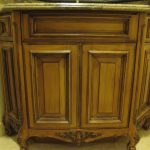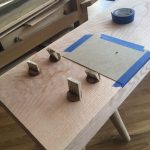We may receive a commission when you use our affiliate links. However, this does not impact our recommendations.

Caleb began his woodworking career designing and creating mid-century furniture, with a focus on Danish modern chairs. His entry into traditional chair making began with training from Peter Galbert and further expanded as he collaborated with Curtis Buchanan. This traditional type of woodworking guided his research into traditional tooling and led to his making 18th-century wooden handplanes. He regularly blogs about plane making and encourages the craft.
PW: You’re known for both Danish modern furniture and 19th century tools – do you see a path from one to the other?
CJ: I don’t necessarily see a direct path, but there is a definite connection for me. One is that Danish designers took the approach of not starting from scratch to design totally new work but rather they looked at designs that stood the test of time and sought to improve them. From there they realized new designs based on that approach. Also, the philosophy behind their approach was rooted in joining the craftsperson’s skills with factory-made items. From these converging processes, 19th century hand tools were often incorporated into factory work. Especially when it came to the subtle details and final finishes. These factories were often “hybrid” workshops way before that term was coined. So, for me, I definitely see the connection and feel it may be more relevant to today’s craftsperson than ever before.
You’ll be teaching about hollow and round planes, a topic you wrote about for a recent Popular Woodworking Magazine cover story. Why should people be interested in this topic and what can they expect at the presentation?
For me hollows and rounds go beyond the interest of those that only want to make 18th/19th century furniture. For one, learning how tools like this were used before the router came along gives an insight into why things were made the way they were. Also there is a lesson to be taken simply from the proportions of a circle that the plane’s sole is based on. Anyone interested in designing furniture based on whole ratios will find that these tools are rooted in that, so it might add to the palette of design options that they may not have considered before.
During the class I will be familiarizing the attendee with the basics of the construction of these planes and how they can be used to make fundamental moulding profiles. In addition, I will show how to maintain and sharpen the planes for effective use.
Your other two presentations – “How to Make a Raised-Panel Door by Hand” and “Danish Modern Furniture” – are, at least at first glance, worlds apart: One’s an ancient technique, while the other’s roots are less than a century old. How would you pitch the presentations to a person interested in attending both?
Frankly, I could see that many might want to attend one of the presentations while not having any interest in the other. However, as I mentioned in a previous answer, Danish furniture has its roots deep in studying tried and true construction techniques in order to advance new designs for our current lifestyles, while taking advantage of current technology. I might compare it to one who would learn about 17th century joiners’ wood even though they don’t ever plan to start working wood from the log. Understanding what came before supports what comes after.
On the other hand, I hope the person who wants to learn about raised panel planes would open their mind to Danish-designed furniture. I would venture to say that those who appreciate Stickley/Arts & Crafts and Shaker furniture would very much appreciate Danish modern furniture. Many of the same ideals are held in common: Great joinery, respect for the materials, craftsmanship, high quality, clean and simple lines, functionality and durable natural finishes. I think the majority of woodworkers appreciate those qualities in their craft.
You’re known to make a tool design from different woods – I see spokeshaves in beech, apple, pear and persimmon on your Instagram page. What’s the reasoning behind varying your materials? Do you learn anything from working with different woods?
Beech was the most common wood for commercially-produced wooden tools. It has all the right qualities for planes and is readily available in large sizes. I use it for the same reasons. I often seek out fruit woods in addition to beech. Fruit woods are very stable when quartersawn and they are typically very dense and hard, which makes them ideal for heavy use. Some woods have special characteristics that are particularly useful, such as persimmon. It is used for the “boxing” on sole areas that receive a lot of abuse. I like to use native woods in particular. Persimmon is the only North American ebony, so it works beautifully for that purpose. One other factor that’s worth considering is that some woods feel nicer in the hands for certain tools. It’s a preference thing.
You embrace the term “maker,” saying you’ve been one for as long as you can remember. How did you come to “makerhood,” and what do you see as the maker’s role in 2016 and beyond?
I embrace the term maker primarily because there are so many prefixes to that word, such as “chair”maker or “plane”maker – both of which I have used in the past. Rather than labeling myself in a specific category, I prefer to leave it open. I know that my interests also lie in basket making or furniture making in general. I like to make things, and I’m quite certain that will be my profession from here on out, whatever it is that I make. Therefore, I feel that “maker” is simply the best way to describe me.
I think the maker’s role for those that do it for a living will be what it is for skilled crafts such as jewelers. They will never compete on a large scale individually but may make up a large industry as a whole when considering all the individual makers. They will cater to those who either appreciate a high level of craft despite their income level or to those who can more easily obtain it because of higher income. Then there will always be those who are makers because it’s their passion. I came from that place myself. 🙂
You’ll be a part of the plane maker roundtable – what is it about planes that excites you and keeps you excited to produce them?
I love seeing a simple tool work effortlessly. It brings me joy to see something that I made perform very well. Seeing the parts come together in just the right way is always a challenge that never seems to get old. Plane making, especially side escapement planes, allows so much room for exploration and experimentation that there is always something to look forward to.
What are you currently working on?
I’m working on a variety of planes while also exploring new tools. I am very interested in developing chairmaking tools and continually prototype new versions of antique tools. Some marking and measuring tools keep popping up in my explorations so I imagine I might see some of those being produced at some point. I also have always seem to have a new chair design somewhere on the back burner that occasionally causes me to drop everything and build it when the urge takes hold.
Here are some supplies and tools we find essential in our everyday work around the shop. We may receive a commission from sales referred by our links; however, we have carefully selected these products for their usefulness and quality.









